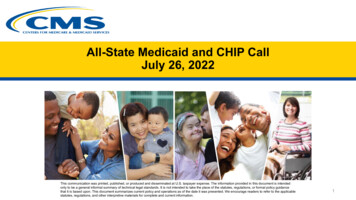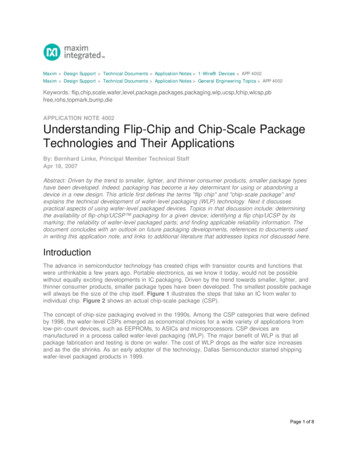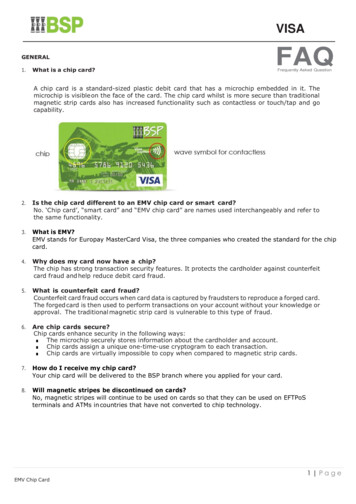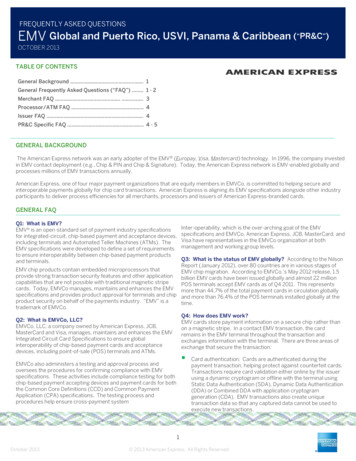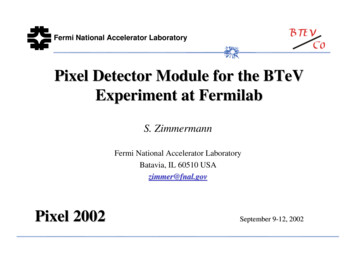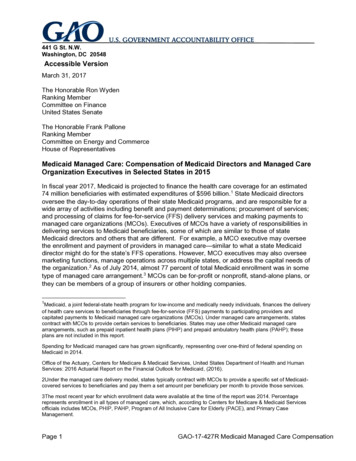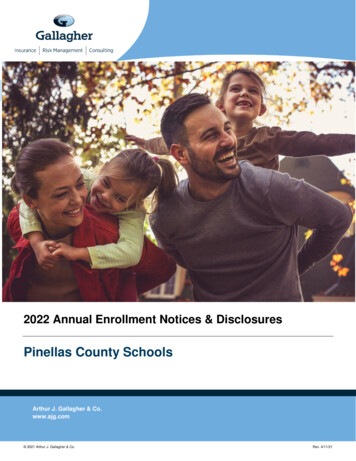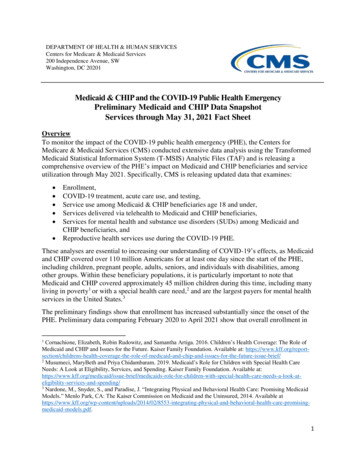
Transcription
DEPARTMENT OF HEALTH & HUMAN SERVICESCenters for Medicare & Medicaid Services200 Independence Avenue, SWWashington, DC 20201Medicaid & CHIP and the COVID-19 Public Health EmergencyPreliminary Medicaid and CHIP Data SnapshotServices through May 31, 2021 Fact SheetOverviewTo monitor the impact of the COVID-19 public health emergency (PHE), the Centers forMedicare & Medicaid Services (CMS) conducted extensive data analysis using the TransformedMedicaid Statistical Information System (T-MSIS) Analytic Files (TAF) and is releasing acomprehensive overview of the PHE’s impact on Medicaid and CHIP beneficiaries and serviceutilization through May 2021. Specifically, CMS is releasing updated data that examines: Enrollment,COVID-19 treatment, acute care use, and testing,Service use among Medicaid & CHIP beneficiaries age 18 and under,Services delivered via telehealth to Medicaid and CHIP beneficiaries,Services for mental health and substance use disorders (SUDs) among Medicaid andCHIP beneficiaries, andReproductive health services use during the COVID-19 PHE.These analyses are essential to increasing our understanding of COVID-19’s effects, as Medicaidand CHIP covered over 110 million Americans for at least one day since the start of the PHE,including children, pregnant people, adults, seniors, and individuals with disabilities, amongother groups. Within these beneficiary populations, it is particularly important to note thatMedicaid and CHIP covered approximately 45 million children during this time, including manyliving in poverty1 or with a special health care need,2 and are the largest payers for mental healthservices in the United States.3The preliminary findings show that enrollment has increased substantially since the onset of thePHE. Preliminary data comparing February 2020 to April 2021 show that overall enrollment inCornachione, Elizabeth, Robin Rudowitz, and Samantha Artiga. 2016. Children’s Health Coverage: The Role ofMedicaid and CHIP and Issues for the Future. Kaiser Family Foundation. Available at: -for-the-future-issue-brief/2Musumeci, MaryBeth and Priya Chidambaram. 2019. Medicaid’s Role for Children with Special Health CareNeeds: A Look at Eligibility, Services, and Spending. Kaiser Family Foundation. Available done, M., Snyder, S., and Paradise, J. “Integrating Physical and Behavioral Health Care: Promising MedicaidModels.” Menlo Park, CA: The Kaiser Commission on Medicaid and the Uninsured, 2014. Available e-promisingmedicaid-models.pdf.11
Medicaid and CHIP increased by over 10%, with the greatest percentage increases found in thepregnant, adult expansion, and other adult eligibility groupsFrom a COVID-19 treatment standpoint, nearly 4.1 million beneficiaries have received treatmentfor COVID-19 through May 2021, with over 340,000 hospitalizations and more than 34 millionCOVID-19 tests covered via the programs. Further, the secondary impacts of COVID-19 onservice utilization have been significant. For children, service utilization across many keydomains, such as primary, preventive, dental, and mental health services, has dropped over thecourse of the PHE. Although rates have rebounded through March 2021 for many of theseservices, millions of services still need to be delivered to make up for those missed betweenMarch 2020 and May 2021. Of all services examined in this analysis, the smallest recovery hasbeen for mental health services and dental services. Although service delivery for children viatelehealth has increased dramatically since the onset of the PHE, this increase has not beensubstantial enough to fully offset the decline in service utilization.This release includes an updated section on reproductive health services utilization. This is animportant addition, as Medicaid is the largest payer for maternity care in the United States,covering more than 4 in 10 births. This analysis found that although the number of beneficiariesin eligibility groups for adults increased, especially for pregnant people and expansion adults,reproductive health service use declined or remained steady during the PHE. Further, theprovision of any contraceptives and long-acting reversible contraception dropped in April 2020and rebounded through March 2021, though there is still a gap in services compared to pre-PHElevels. Perinatal services utilization declined, including prenatal and postpartum visits andbundled payments, which may be tied to the decrease in the number of live births, miscarriages,and stillbirths. However, we might expect increases in postpartum services in the future (?)due toextended postpartum care coverage. due to the requirement that states maintain coverage foreligible people for the duration of the PHETaken together, CMS’s release of COVID-19 data is a major step toward sharing timely data onthe nation’s largest health coverage program. These results are essential not only for ensuringrobust monitoring and oversight of Medicaid and CHIP, but also for highlighting the distinctimpact COVID-19 has had on children’s service utilization, telehealth utilization, services formental health and SUDs, and reproductive health services. By using these results, CMS, states,and other key stakeholders can help drive better health outcomes for some of our nation’s mostvulnerable beneficiaries.FindingsEnrollment: Preliminary data comparing February 2020 to April 2021 show that overallenrollment in Medicaid and CHIP increased by over 10%, with the greatest percentage increasesfound in the pregnant, adult expansion, and other adult eligibility groups. Comparing February2020 to April 2021, the data show approximately12% more (10.2 million) beneficiaries enrolledin Medicaid or CHIP, 50% more (489,000) beneficiaries in the pregnant eligibility group, 27%more (4.1 million) beneficiaries in the adult expansion eligibility group, and 20% more (2.1million) beneficiaries in other adult eligibility groups4. There were 1% fewer beneficiaries in the4Other adult eligibility groups include beneficiaries who are older than 21 and fall into categories such as parentsand other caretaker relatives, transitional Medicaid Assistance, extended Medicaid due to spousal support, andpregnant women.2
blind and disabled eligibility group and 2% fewer beneficiaries in the CHIP children eligibilitygroup.COVID-19 treatment, acute care use, and outcomes: For COVID-19 treatment and outcomes,nearly 4.1 million beneficiaries have received treatment and more than 340,000 Medicaid andCHIP beneficiaries have been hospitalized through the end of May 2021. Further, Medicaid andCHIP have paid for nearly 34.1 million COVID-19 tests or testing-related services since the startof the PHE, not including tests or testing-related services provided free of charge or covered byother insurance programs, including Medicare.Service utilization among Medicaid & CHIP beneficiaries age 18 and under: There has been adecline in service use among enrollees age 18 and under across a number of key domains. Whencompared to data from the same time period two years prior, preliminary data for the PHE show1.6 million (2%) fewer vaccinations for beneficiaries up to age 18, 2.2 million (6%) fewer childscreening services, 17.6 million (24%) fewer mental health services, and 12.6 million (24%)fewer dental services. Although rates across many domains are starting to rebound, millions ofservices still need to be delivered to make up for those missed between March 2020 and May2021. However, there is considerable state variation in service use rates, with some statesreturning to or surpassing February 2020 levels of care by June 2020.Services delivered via telehealth: The results demonstrate that the number of services deliveredvia telehealth surged during the PHE, with more nearly 144 million services delivered viatelehealth. This represents an increase of more than 3,700% compared to the same period fromtwo years prior.Services for mental health and SUD among Medicaid & CHIP beneficiaries: For children, therehas been a substantial decline in service use since April 2020, with declines continuing throughMarch 2021 in nearly all states. When compared to data from the same time period from twoyears prior, preliminary data for 2020 show 17.6 million (24%) fewer mental health services forchildren. For adults age 19 to 64 for both mental health services and SUD services, there appearsto be a trend in which the volume of mental health services during the PHE has returned to prePHE levels, while the gap in the rate of services has grown. This ongoing gap in the utilizationrate is likely due to the large increase in enrollment in the adult and adult expansion eligibilitygroups.Reproductive health services: Preliminary data suggest that, during the PHE, the provision ofany contraceptives and long-acting reversible contraception dropped in April 2020 andrebounded through March 2021, though there is still a gap in services compared to pre-PHElevels. The number of live births, miscarriages, and stillbirths during the PHE are lower thanprior years’ levels. The decline in pregnancy outcomes in earlier months of the PHE is notattributable to COVID-19 since these pregnancies were initiated prior to March 2020 (the start ofthe PHE). The number of beneficiaries in adult eligibility groups increased, especially forpregnant people and expansion adults. Despite this trend, reproductive health service usedeclined or remained steady during the PHE. Perinatal services declined,including prenatal andpostpartum visits and bundled payments, which may be tied to the decrease in the number oflive births, miscarriages, and stillbirths. However, we might expect increases in postpartumservices due to extended postpartum care coverage due to the requirement that states maintaincoverage for eligible people for the duration of the PHE.3
For each set of the results, the estimates reflect services that are covered by Medicaid and CHIP.Services covered by other insurance programs, such as Medicare, are not included in theseresults. Given that there is a sizable population enrolled in both Medicare and Medicaid, with12.3 million dually eligible beneficiaries in 2019,5 the results are unlikely to reflect the full scopeof COVID-19 related treatments for dually eligible beneficiaries, as Medicare pays first forMedicare-covered services that are also covered by Medicaid because Medicaid is generally thepayer of last resort.6 For more information about COVID-19 related cases and hospitalizationsamong dually eligible beneficiaries covered by Medicare, refer to CMS' Medicare COVID-19Data Snapshot.Data Sources & DefinitionsMedicaid and CHIP providers, managed care agencies, and Pharmacy Benefit Managers submitadministrative claims data to state Medicaid and CHIP agencies for processing. Those stateagencies subsequently submit the data to CMS on a monthly basis via T-MSIS, a uniform,national data system for Medicaid and CHIP. Because T-MSIS submissions are difficult toanalyze due to their large size and complex relational structure, CMS developed the researchoptimized TAF to facilitate the analysis of Medicaid and CHIP data. Additional informationabout TAF can be found here. This data snapshot utilizes the 2018-2021 TAF to monitor ongoingoutcomes related to COVID-19, including measures of Medicaid and CHIP enrollment, COVIDrelated treatment, and service use. Due to claims submission lags related to state processing andsubmission via T-MSIS, this analysis primarily focuses on service utilization and healthoutcomes through the end of May 2021.CMS measured enrollment, forgone care, and COVID-related treatment using the followinglogic:Enrollment: This analysis includes records for every beneficiary who has any Medicaidor CHIP enrollment record in a given month, regardless of the scope of their benefits.Vaccinations: Vaccinations are identified by Current Procedural Terminology (CPT)codes. The vaccines included in this analysis are DTaP, Polio, MMR, Hepatitis B, Hib,Pneumococcal conjugate, Chickenpox, Hepatitis A, and Rotavirus.Child screening services: Child screenings are identified by two types of codes inclaims. The first type is CPT codes that are specific to visits by new or establishedpatients (99381-99385 or 99391-99395) and to initial hospital or birth center care fornewborns (99460, 99461, 99463). The second type is general CPT codes for new (99202–99205) or established (99213–99215) patients along with a diagnosis code indicating thatthe service was provided to a child younger than 19 (e.g., Z00.110 Health examinationfor newborn under 8 days old).Centers for Medicare and Medicaid Services. Medicare-Medicaid Coordination Office. “Data Analysis Brief:Medicare-Medicaid Dual Enrollment 2006 through 2019.” Available Centers for Medicare and Medicaid Services. Medicare-Medicaid Coordination Office. “Dually EligibleIndividuals – Categories.” Available at: rolleeCategories.pdf54
Dental Services: Dental services are defined on the basis of the Current DentalTerminology (CDT) and CPT code groups from standard annual reporting of the states’provision of Early and Periodic Screening, Diagnostic and Treatment services (CMS416).Mental health services: Mental health services are identified by claims in which thediagnosis is a mental health condition. In addition to diagnosis, the services are groupedon the claim by type: inpatient, intensive outpatient/partial hospitalization, outpatient,emergency department, and telehealth.Substance Use Disorder (SUD) services: Substance use disorder services are identifiedby claims in which the diagnosis is a substance use disorder. In addition to diagnosis, theservices are grouped on the claim by type: inpatient, intensive outpatient/partialhospitalization, outpatient, emergency department, and telehealth.Telehealth: Telehealth is identified through a combination of procedure codes andprocedure code modifiers.COVID testing services: All COVID-19 testing services are grouped into threecategories: diagnostic testing, antibody testing, and specimen collection. Diagnostictesting indicates whether an individual has COVID-19. Antibody testing is designed todetect antibodies produced in response to being previously exposed to COVID-19.Specimen collection is the process of obtaining the samples that are necessary to test forCOVID-19. Diagnostic testing is identified via Healthcare Common Procedural CodingSystem (HCPCS) codes U0001, U0002, U0003, and U004 and CPT code 87635.Antibody testing is identified via CPT codes 86328 and 86769. Specimen collection isidentified via HCPCS codes G2023 and G2024.COVID-19 treatment: We use the following International Classification of Diseases(ICD), Tenth Revision (ICD-10), diagnosis codes to identify beneficiaries who receivedtreatment for COVID-19: B97.29 (other coronavirus as the cause of diseases classified elsewhere) - beforeApril 1, 2020U07.1 (2019 Novel Coronavirus, COVID-19) – from April 1, 2020 onward.Although CMS does use laboratory claims for identifying COVID-19 treatment, CMSdoes not receive lab results from states and cannot determine whether a lab test waspositive. Therefore, Medicaid & CHIP COVID-19 cases are only identifiable in TAF datawhen there is a corresponding COVID-19 related service.Reproductive health services: Reproductive health services are identified using theCommon Procedure Coding System (HCPCS), Current Procedural Terminology (CPT),ICD-10 diagnoses and procedures (ICD10-CM or ICD10-PCS), National Drug Codes(NDC), and revenue codes (UBREV) for female Medicaid and CHIP beneficiaries ages15 to 44.Key ConsiderationsReaders should use caution when interpreting these results as CMS collects Medicaid and CHIPdata for programmatic purposes, not for public health surveillance. Given the complex process of5
states collecting, processing, and transmitting claims via T-MSIS, it can take nearly 7 months forCMS to receive 90% of claims. Therefore, this delay between when a service occurs and when itis reflected in the T-MSIS Analytic Files, or the “claims lag,” may impact the accuracy of theresults. The length of the lag depends on the submitting state, claim type, and delivery system. Itis possible that there is a longer claims lag due to the COVID-19 pandemic. Further, in additionto claims lag, states vary widely in terms of the completeness and accuracy of their T-MSIS datasubmissions. Additional information about state data quality can be found here and here.Next StepsCMS is committed to working with state Medicaid and CHIP agencies to help close these gaps inchildren's health care and in treatment for mental health conditions, and we will continue tomonitor both the direct and indirect impacts of COVID-19 on the Medicaid and CHIPpopulations using TAF data.6
Medicare-covered services that are also covered by Medicaid because Medicaid is generally the payer of last resort.6 For more information about COVID-19 related cases and hospitalizations among dually eligible beneficiaries covered by Medicare, refer to CMS' Medicare COVID-19 Data Snapshot. Data Sources & Definitions



